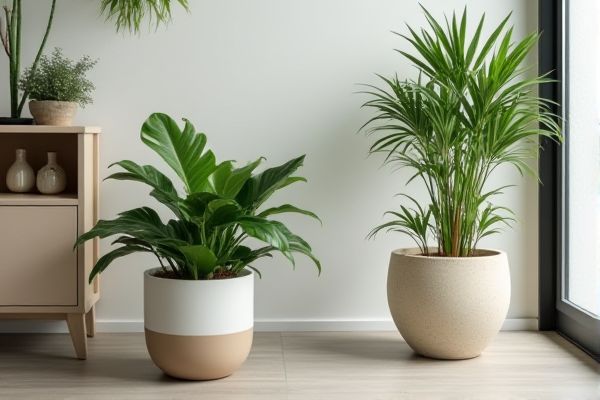
Plastic planters are lightweight, durable, and retain moisture well, making them ideal for indoor gardening and those who want low-maintenance options. Ceramic planters offer a stylish, porous surface that promotes better aeration but are heavier and more fragile, so explore the differences further to find the perfect choice for your plants and space.
Table of Comparison
| Feature | Plastic Planter | Ceramic Planter |
|---|---|---|
| Weight | Lightweight, easy to move | Heavy, less portable |
| Durability | Resistant to breakage, flexible | Fragile, prone to cracking |
| Water Retention | Retains moisture well, less porous | Porous, allows soil to dry faster |
| Cost | Affordable, budget-friendly | Generally more expensive |
| Design & Aesthetics | Wide variety, less natural look | Elegant, natural, handcrafted appearance |
| Environmental Impact | Non-biodegradable, recyclable options vary | Biodegradable, eco-friendly material |
| Temperature Sensitivity | Less affected by temperature changes | Can crack in extreme cold |
Introduction to Plastic and Ceramic Planters
Plastic planters offer lightweight durability and cost-effectiveness, making them ideal for both indoor and outdoor gardening. Ceramic planters provide superior breathability and aesthetic appeal, often favored for decorative purposes and better moisture regulation. Choosing between plastic and ceramic depends on factors such as plant type, environmental conditions, and design preferences.
Material Composition and Durability
Plastic planters are made from lightweight synthetic polymers like polyethylene or polypropylene, offering high impact resistance and flexibility, making them less prone to cracking or breaking when dropped. Ceramic planters, composed of fired clay or porcelain, provide excellent weight and stability but are more fragile, often susceptible to chipping or cracking under stress or extreme temperature changes. Choosing plastic planters enhances durability and portability, while ceramic planters offer aesthetic appeal with a higher risk of damage over time.
Weight and Portability Comparison
Plastic planters are significantly lighter than ceramic planters, making them easier to move and ideal for balconies or areas where frequent repositioning is required. Ceramic planters, while heavier and less portable, offer greater stability and are less prone to tipping over in windy conditions. Your choice depends on whether weight and portability or durability and sturdiness are more important for your gardening needs.
Design and Aesthetic Appeal
Plastic planters offer versatile designs with a wide range of colors, shapes, and lightweight textures ideal for modern, casual spaces. Ceramic planters provide a classic, elegant aesthetic with glossy or matte finishes, often featuring intricate patterns that enhance traditional or sophisticated decor. Your choice depends on whether you prefer the customizable, low-maintenance appeal of plastic or the durable, artistic beauty of ceramic for your indoor or outdoor plants.
Drainage and Plant Health
Plastic planters typically have built-in drainage holes that help prevent waterlogging, promoting healthy root development by allowing excess water to escape easily. Ceramic planters, especially glazed ones, often lack sufficient drainage, increasing the risk of root rot and poor aeration if not handled carefully. Choosing a planter with proper drainage is essential for maintaining optimal soil moisture and ensuring long-term plant health.
Cost Effectiveness and Affordability
Plastic planters offer superior cost effectiveness and affordability compared to ceramic planters, as they are generally less expensive to manufacture and purchase. Their lightweight nature reduces shipping costs and makes them ideal for budget-conscious gardeners seeking durable options. Ceramic planters, while often more aesthetically pleasing, tend to be pricier and require more careful handling, increasing overall investment.
Environmental Impact and Sustainability
Plastic planters often have a lower environmental footprint during production due to less energy consumption compared to ceramic planters, which require high-temperature kilns emitting significant CO2. However, plastic's durability leads to longer use and less frequent replacement, yet it poses sustainability challenges as it is less biodegradable and often ends up in landfills or oceans. Your choice should weigh the recyclability of plastic planters against the natural, eco-friendly materials of ceramic options that break down more easily but may need more resources to replace over time.
Suitable Plant Types for Each Planter
Plastic planters are ideal for moisture-loving plants like ferns, succulents, and herbs due to their lightweight, moisture-retentive properties that prevent soil from drying out quickly. Ceramic planters suit plants that prefer well-drained soil, such as cacti, orchids, and African violets, as their porous material allows better airflow and prevents root rot. Choosing the right planter enhances your plant's health by matching its water and aeration needs effectively.
Indoor vs Outdoor Usage
Plastic planters excel in outdoor usage due to their lightweight, weather-resistant properties and durability against UV rays and temperature fluctuations, making them ideal for patios and gardens. Ceramic planters offer superior breathability and moisture retention, which benefits indoor plants by preventing root rot and maintaining consistent soil conditions but are more fragile and less suited for outdoor environments where they risk cracking from exposure. For indoor environments, ceramic planters enhance aesthetic appeal and plant health, while plastic planters provide practicality and resilience in outdoor settings.
Final Verdict: Choosing the Right Planter
Plastic planters offer lightweight durability and excellent moisture retention, making them ideal for indoor plants and quick repotting. Ceramic planters provide superior insulation and aesthetic appeal with their diverse designs, but they are heavier and more prone to cracking. Choosing the right planter depends on balancing weight preferences, plant type, drainage needs, and style considerations to optimize plant health and decor.
 homyna.com
homyna.com